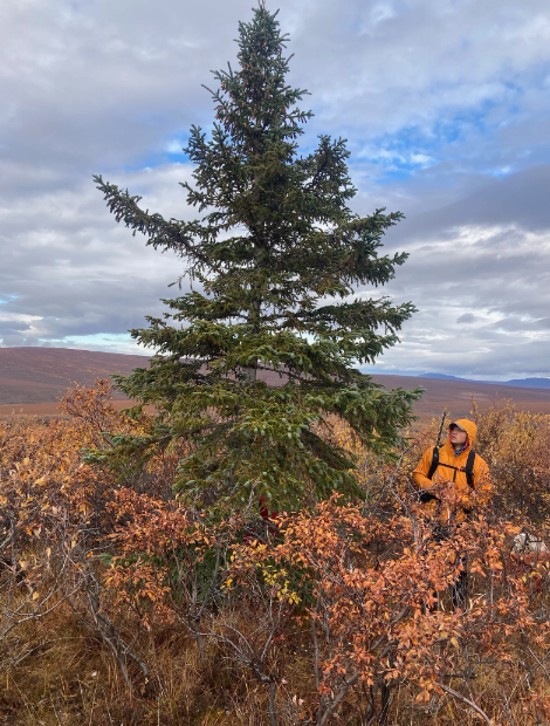Trees are growing in the Arctic tundra where none have survived before. The Arctic is warming four times faster than the rest of the planet which means the barriers that made Arctic terrain hostile to trees are diminishing. Forests are marching towards the North Pole.
Last August a paper appeared in the Journal Nature entitled, “Sufficient conditions for rapid range expansion of a boreal conifer.” It is one of a number of documents describing a changing pattern of tree growth and range across the Arctic landscape in Alaska, Siberia, Canada, and Scandinavia. The more trees establish themselves in high-latitude environments, the faster warming is coming as a low albedo effect takes hold.
The paper described what was happening to the North American White Spruce population in Alaska’s tundra conditions. White Spruce require temperatures of 10 Celsius (50 Fahrenheit) or greater for seeds to germinate. And White Spruce don’t start producing seeds until they are 30 years of age. So seeing an expanding population of White Spruce in areas where none have been observed in human recorded history is rather compelling evidence that the Arctic climate conditions are undergoing significant change. The rate of the northward march is about 4 kilometres (2.5 miles) per decade. The advance corresponds with both rising land temperatures and disappearing sea ice.
The data for the study comes from a field survey done in 2019 where previously unknown White Spruce forests appeared to be well established in the Noatak River basin of Alaska. The Noatak drains into the Chukchi Sea which is seeing the fastest rate of sea ice decline within the Arctic Ocean. The forest included trees of all sizes with a well-established treeline extending 42 kilometres (more than 26 miles). They appeared to have propagated from a population of trees first established at the beginning of the 20th century. These parent trees remained confined to a small area during the first half of the century. But in recent decades, that is, since the mid-20th century has expanded their range. Initially, the rate was 1.4 kilometres (0.8 miles) per decade. But now the rate is accelerating. Juvenile trees seeded from their parent population are now over 35 years old and seeding areas even further into the tundra.
Previously I referred to the albedo effect. What is it? High and low albedo describes changes in the way the Earth absorbs or reflects sunlight. Whether high or low, albedo effects create feedback loops. Earth’s average albedo is 0.3, meaning 30% of sunlight gets reflected back into space while 70% contributes to the planet’s warming. A high albedo occurs when light from the Sun gets reflected by the Earth’s surface. Snow and ice cover have a 0.8 albedo effect. That is, they reflect 80% of the sunlight back into space and absorb only 20% of its energy. Low albedo happens when the Earth’s surface is darkened by vegetation, or water surfaces become ice-free. Low albedo contributes to the heating of the air above these surfaces. Forests have a 0.15 albedo. They reflect 15% of the sunlight and absorb 85%. So the presence of a growing forest of conifers such as the White Spruce in this study acts to accelerate Arctic warming providing the feedback loop the Alaskan Arctic is experiencing that I referred to earlier.
Take into consideration the fecundity of these trees. A typical White Spruce spreads its seeds up to 60 metres (almost 200 feet). But with the feedback loop creating increased warmth the dispersal range has grown to as much as 800 metres (almost a half mile). The scientists who wrote the paper in Nature note that the trees they observed appear to be healthy and growing in Arctic conditions which have warmed by as much as 2.3 Celsius (4.14 Fahrenheit) degrees over the last one hundred years.
In addition, the scientists note that winter precipitation has been increasing and soil conditions are changing with increasing microbial activity leading to greater nutrient availability and a longer growing season. Hence we are seeing trees interspersed with normal tundra vegetation that are as tall and healthy as the one seen in the picture at the top of this posting.
One of the research scientists describes the spread of White Spruce as not moving but rather leaping north. Roman Dial, of Alaska Pacific University, in a recent article appearing in Wired notes, “These new colonists, you’d think that they’re beyond the tree line, they should just be struggling. But they’re actually growing really rapidly. They’re happy as pigs in poop—they’re just going gangbusters out there in the Arctic tundra and alpine tundra. They’re way ahead. They’re even doing better than the shrubs.”
















